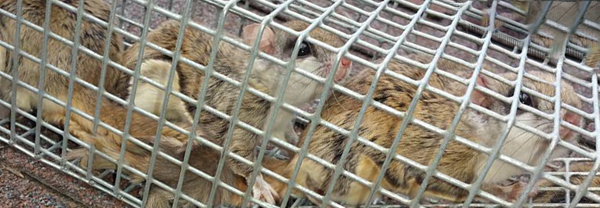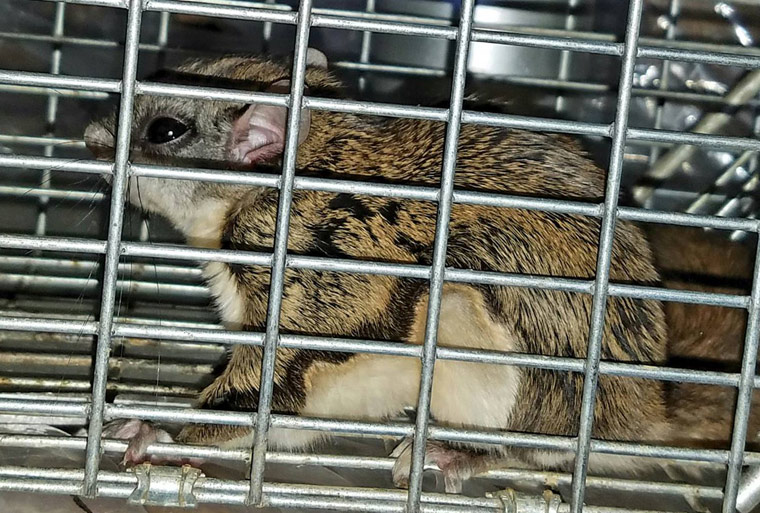- info@wildlife-removal.com
Call us for help in your town
Wildlife Removal Education
About Flying Squirrel Biology
Need squirrel removal in your hometown? We service over 500 USA locations! Click here to hire us in your town and check prices - updated for year 2020.
There are over 40 species of flying squirrels, some of which are - Northern flying squirrels, Southern flying squirrels, Woolly flying squirrels, Afghan flying squirrels, Hairy footed flying squirrels, Red giant flying squirrels, whiskered flying squirrels, Black flying squirrels, and Arrow flying squirrels among others. The largest known flying squirrels are the woolly flying squirrels, which are mainly found in Pakistan, and the Pigmy flying squirrels that inhabit Malaysia and Borneo are the smallest flying squirrels known.

Birds of prey, foxes, raccoons, snakes, cats, coyotes, even domestic cats and dogs and other related animals are the natural predators of flying squirrels due to their small size. However, predating flying squirrels is usually a cumbersome thing to do as they are nocturnal, only coming out at night, and thereby escaping more of their predators.
Appearance
The flying squirrel is a medium sized, close relative of the common squirrels with an average weight and length of 5 ounces and 10 inches respectively. It possesses furs, large, bulging eyes and a flattened tail. The tail of a flying squirrel, normally used for balancing, can easily break off its body without any adverse result. Though they usually have whitish belly, their coat colour ranges from black to brown, tan, white or grey. Their distinctive feature is a stretchy and furry membrane that links the front and hind limbs, called the patagia.
Behaviour
Flying squirrels do not actually fly like birds or bats, they only have the ability to glide from one tree to another with their patagia (a rubber-like membrane between their legs). The normal gliding distance of a flying squirrel is between 23 meters to 45 meters, but the longest recorded distance ever stands at 90 meters. They open their patagia like a parachute when in the air and they use their paws for landing while the tail functions like brake during the landing process.
They are also nocturnal and their large, bulging eyes are adapted for foraging at night. Another adaptive feature for after dark foraging activities is the flying squirrel’s feelers, which are specialized whiskers that aid their ability to feel their surroundings at night. They forage at night to find foods and this nocturnal nature helps them to keep out of the way of predators. However they often still fall prey to snakes, climbing mammals and birds of prey.
They do not live solitary lives and as such can live in large groups of up to 20 squirrels inside holes in trees or dens. They do not hibernate during winter, but only lessen their activities and they usually come together to keep their bodies warm.
Life cycle
Flying squirrels breed twice in a year, once in early spring and again in the summer. The gestation period of about 38 days follows after mating and finally, an average of 4 baby flying squirrels are born per litter. The new offspring are born naked, blind and helpless and they depend on the mother flying squirrels for the first few months of their lives. The young ones open their eyes and start to have fur by the end of their first week; then they learn to glide from their mother, who takes full responsibility of parenthood. After 3 months, they are capable of gliding perfectly and can leave their mother's nest by then.
The average lifespan of wild flying squirrels is 6 years, though flying squirrels tend to live longer when they are captured and raised by humans; those in zoos for instance, can live up to 15 years.
Habitat
Flying squirrels mainly live around trees and they specifically like to inhabit woodpeckers’ holes, nest boxes, snags, abandoned nests of birds and other squirrels. Some of them may even den in houses or barns. They can glide easily from one tree to another while foraging. They are adapted to living in forests and woodlands at any favourable location all around the world.
Diet
As a result of being dependent on their environment for the type of foods to eat, flying squirrels are omnivores. They tend to eat anything available within their reach. Their major foods are nuts, seeds, fruits, insects, mushroom, eggs, carrion, young mice, vegetables, small snails, spiders, buds, berry etc. They also store up food that will be used during the cold winter months.
Flying Squirrels
Flying squirrels are nocturnal creatures, with different species found in different environments. There are actually around fifty different species recognized, although not all of them are found in the USA. The Southern flying squirrel, Northern flying squirrel, and Humboldt’s flying squirrel are the ones you are most likely to encounter.

Humboldt’s Flying Squirrel
These squirrels have a particular preference for mixed and coniferous forests, meaning that you’ll find them in areas such as Southern California, Oregon, Washington, and even into Southern areas of British Columbia in Canada. Eating sap, insects, carrion, fungi, nestlings and bird eggs, the forests provide them with everything they need, and when it comes to breeding time, they simply find a cozy cavity that they line with soft materials.
Southern Flying Squirrel
This squirrel, as the name would suggest, is found in South and South-Eastern regions, including Florida, the entire East half of North America, and even some of the highlands of hotter places — Honduras and Mexico, for example.
These Southern cousins eat pretty much the same thing as the Humboldt’s squirrel, although it has learned to adapt to more types of home range, allowing it to become the most prolific of the three flying squirrel species found in North America.
Northern Flying Squirrel
Just like others, the Northern flying squirrel can have subspecies beneath it, and this is where life gets a little complicated when it comes to removing them from your land. The West Virginia Northern flying squirrel was classed as an endangered species, but has since recovered to such an extent that it has been removed from that list. The Carolina Northern Flying Squirrel is STILL classed as an endangered subspecies and is, therefore, protected.
As of 2011, the Northern Flying Squirrel as a whole species was placed under protection by the U.S. Fish and Wildlife Service. This means that you must be VERY careful when removing ANY flying squirrel. If you cannot be sure that it isn't an endangered species, you shouldn't be doing the job yourself.
Behaviors & Breeding
Each of these three flying squirrel species have slightly different appearances and behaviors, although it does appear that they are adapting. Human efforts, including deforestation, have led to the decline of flying squirrel habitats, and this has forced them to get closer to areas that are heavily populated with human. This is something that they would once have avoided at all costs.
The Northern flying squirrel, for example, has started to breed twice per year. It was once established that they only bred once in any twelve months, but reports from Canada and other places seem to point towards more than one litter. When you remember that the species is endangered, you must wonder if deforestation and other factors have forced them to adapt to breed more quickly. This is a process that rats and other rodents have taken on, and it's worked very well in their favor.
The Southern flying squirrel, on the other hand, has always mated a couple of times per year, usually having around five young per litter. It can be as few as two, and as many as seven or eight. They are taken care of until they are about four months old, weaned after a couple of those, and then they are free to do whatever they choose — make a new life or stick around. Large groups of flying squirrels tend to contain more family members, but they are not adverse to letting in ‘outsiders’.
Southern flying squirrels are very sociable animals, congregating together in large groups for a number of reasons. Firstly, it offers protection to huddle together in large groups. Secondly, it gives a greater chance of survival. The mothers will help to rear each other's young. Thirdly, they find warmth in greater numbers during the colder months that winter brings.
Go back to the Flying Squirrel Removal page, or learn tips to do it yourself with my How to Get Rid of Flying Squirrels guide.


















